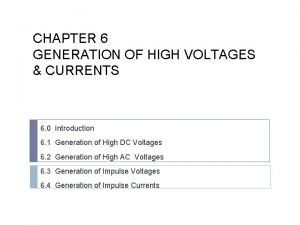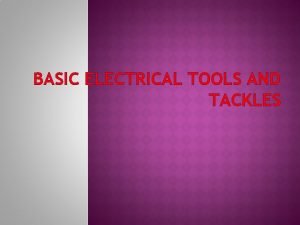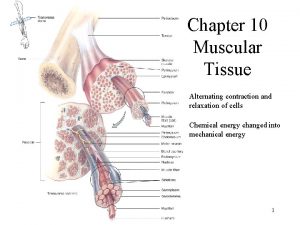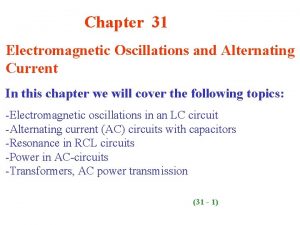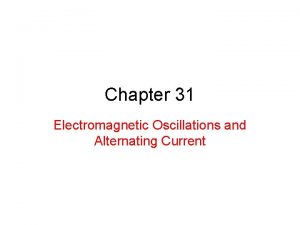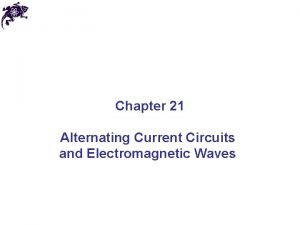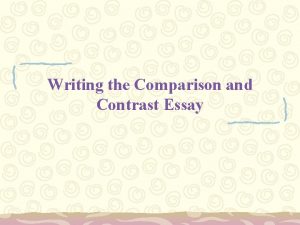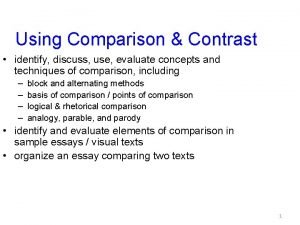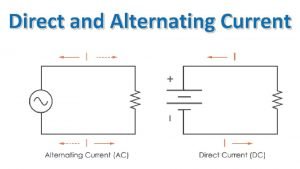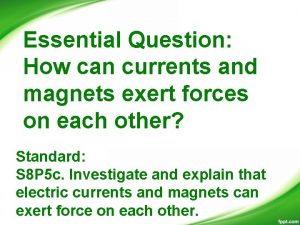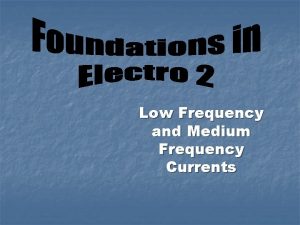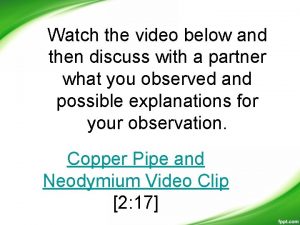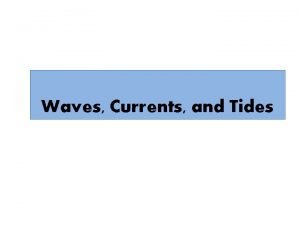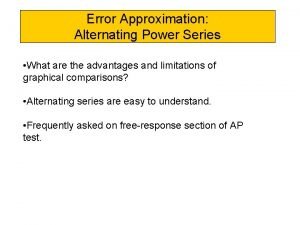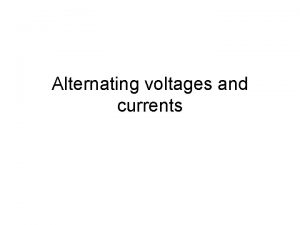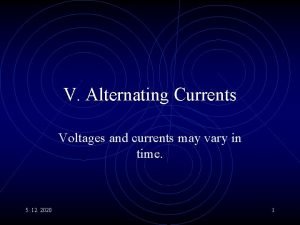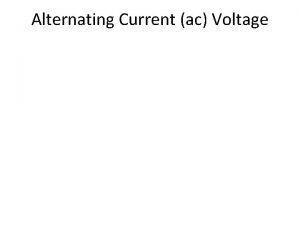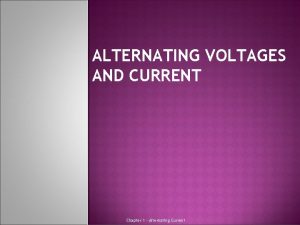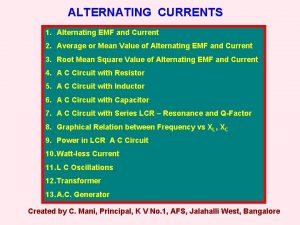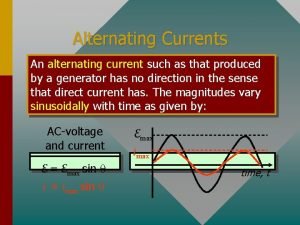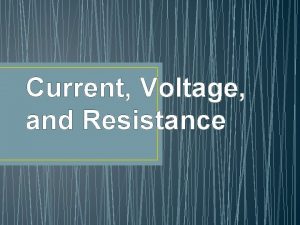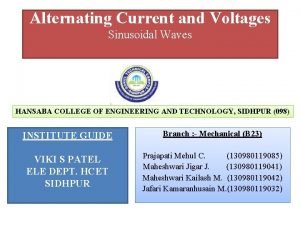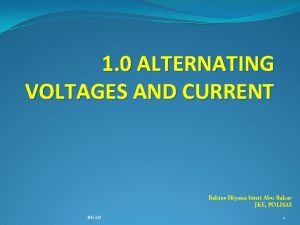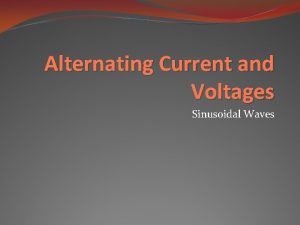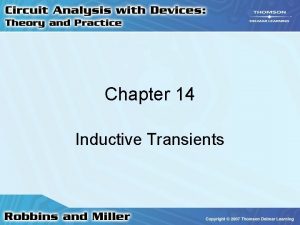Alternating Voltages and Currents Chapter 15 Introduction Voltage

































- Slides: 33

Alternating Voltages and Currents Chapter 15 § Introduction § Voltage and Current § Reactance of Inductors and Capacitors § Phasor Diagrams § Impedance § Complex Notation Storey: Electrical & Electronic Systems © Pearson Education Limited 2004 OHT 15. 1

Introduction 15. 1 § From our earlier discussions we know that where Vp is the peak voltage is the angular frequency is the phase angle § Since = 2 f it follows that the period T is given by Storey: Electrical & Electronic Systems © Pearson Education Limited 2004 OHT 15. 2

§ If is in radians, then a time delay t is given by / as shown below Storey: Electrical & Electronic Systems © Pearson Education Limited 2004 OHT 15. 3

Voltage and Current 15. 2 § Consider the voltages across a resistor, an inductor and a capacitor, with a current of § Resistors – from Ohm’s law we know – therefore if i = Ipsin( t) Storey: Electrical & Electronic Systems © Pearson Education Limited 2004 OHT 15. 4

Voltage and Current 15. 2 § Inductors - in an inductor – therefore if i = Ipsin( t) § Capacitors - in a capacitor – therefore if i = Ipsin( t) Storey: Electrical & Electronic Systems © Pearson Education Limited 2004 OHT 15. 5

Storey: Electrical & Electronic Systems © Pearson Education Limited 2004 OHT 15. 6

Reactance of Inductors and Capacitors 15. 3 § Let us ignore, for the moment the phase angle and consider the magnitudes of the voltages and currents § Let us compare the peak voltage and peak current § Resistance Storey: Electrical & Electronic Systems © Pearson Education Limited 2004 OHT 15. 7

§ Inductance § Capacitance Storey: Electrical & Electronic Systems © Pearson Education Limited 2004 OHT 15. 8

§ The ratio of voltage to current is a measure of how the component opposes the flow of electricity § In a resistor this is termed its resistance § In inductors and capacitors it is termed its reactance § Reactance is given the symbol X § Therefore Reactance Storey: Electrical & Electronic Systems © Pearson Education Limited 2004 OHT 15. 9

§ Since reactance represents the ratio of voltage to current it has units of ohms § The reactance of a component can be used in much the same way as resistance: – for an inductor – for a capacitor Storey: Electrical & Electronic Systems © Pearson Education Limited 2004 OHT 15. 10

§ Example – see Example 15. 3 from course text A sinusoidal voltage of 5 V peak and 100 Hz is applied across an inductor of 25 m. H. What will be the peak current? At this frequency, the reactance of the inductor is given by Therefore Storey: Electrical & Electronic Systems © Pearson Education Limited 2004 OHT 15. 11

Phasor Diagrams 15. 4 § Sinusoidal signals are characterised by their magnitude, their frequency and their phase § In many circuits the frequency is fixed (perhaps at the frequency of the AC supply) and we are interested in only magnitude and phase § In such cases we often use phasor diagrams which represent magnitude and phase within a single diagram Storey: Electrical & Electronic Systems © Pearson Education Limited 2004 OHT 15. 12

§ Examples of phasor diagrams (a) here L represents the magnitude and the phase of a sinusoidal signal (b) shows the voltages across a resistor, an inductor and a capacitor for the same sinusoidal current Storey: Electrical & Electronic Systems © Pearson Education Limited 2004 OHT 15. 13

§ Phasor diagrams can be used to represent the addition of signals. This gives both the magnitude and phase of the resultant signal Storey: Electrical & Electronic Systems © Pearson Education Limited 2004 OHT 15. 14

§ Phasor diagrams can also be used to show the subtraction of signals Storey: Electrical & Electronic Systems © Pearson Education Limited 2004 OHT 15. 15

§ Phasor analysis of an RL circuit § See Example 15. 5 in the text for a numerical example Storey: Electrical & Electronic Systems © Pearson Education Limited 2004 OHT 15. 16

§ Phasor analysis of an RC circuit § See Example 15. 6 in the text for a numerical example Storey: Electrical & Electronic Systems © Pearson Education Limited 2004 OHT 15. 17

§ Phasor analysis of an RLC circuit Storey: Electrical & Electronic Systems © Pearson Education Limited 2004 OHT 15. 18

§ Phasor analysis of parallel circuits in such circuits the voltage across each of the components is the same and it is the currents that are of interest Storey: Electrical & Electronic Systems © Pearson Education Limited 2004 OHT 15. 19

Impedance 15. 5 § In circuits containing only resistive elements the current is related to the applied voltage by the resistance of the arrangement § In circuits containing reactive, as well as resistive elements, the current is related to the applied voltage by the impedance, Z of the arrangement – this reflects not only the magnitude of the current but also its phase – impedance can be used in reactive circuits in a similar manner to the way resistance is used in resistive circuits Storey: Electrical & Electronic Systems © Pearson Education Limited 2004 OHT 15. 20

§ Consider the following circuit and its phasor diagram Storey: Electrical & Electronic Systems © Pearson Education Limited 2004 OHT 15. 21

§ From the phasor diagram it is clear that the magnitude of the voltage across the arrangement V is where § Z is the magnitude of the impedance, so Z =|Z| Storey: Electrical & Electronic Systems © Pearson Education Limited 2004 OHT 15. 22

§ From the phasor diagram the phase angle of the impedance is given by § This circuit contains an inductor but a similar analysis can be done for circuits containing capacitors § In general and Storey: Electrical & Electronic Systems © Pearson Education Limited 2004 OHT 15. 23

§ A graphical representation of impedance Storey: Electrical & Electronic Systems © Pearson Education Limited 2004 OHT 15. 24

Complex Notation 15. 6 § Phasor diagrams are similar to Argand Diagrams used in complex mathematics § We can also represent impedance using complex notation where § Resistors: ZR = R § Inductors: ZL = j. XL = § Capacitors: ZC = -j. XC = Storey: Electrical & Electronic Systems © Pearson Education Limited 2004 j L OHT 15. 25

§ Graphical representation of complex impedance Storey: Electrical & Electronic Systems © Pearson Education Limited 2004 OHT 15. 26

§ Series and parallel combinations of impedances – impedances combine in the same way as resistors Storey: Electrical & Electronic Systems © Pearson Education Limited 2004 OHT 15. 27

§ Manipulating complex impedances – complex impedances can be added, subtracted, multiplied and divided in the same way as other complex quantities – they can also be expressed in a range of forms such as the rectangular, polar and exponential forms – if you are unfamiliar with the manipulation of complex quantities (or would like a little revision on this topic) see Appendix D of the course text which gives a tutorial on this subject Storey: Electrical & Electronic Systems © Pearson Education Limited 2004 OHT 15. 28

§ Example – see Example 15. 7 in the course text Determine the complex impedance of this circuit at a frequency of 50 Hz. At 50 Hz, the angular frequency = 2 f = 2 50 = 314 rad/s Therefore Storey: Electrical & Electronic Systems © Pearson Education Limited 2004 OHT 15. 29

§ Using complex impedance § Example – see Section 15. 6. 4 in course text Determine the current in this circuit. Since v = 100 sin 250 t , then = 250 Therefore Storey: Electrical & Electronic Systems © Pearson Education Limited 2004 OHT 15. 30

§ Example (continued) The current is given by v/Z and this is easier to compute in polar form Therefore Storey: Electrical & Electronic Systems © Pearson Education Limited 2004 OHT 15. 31

§ A further example A more complex task is to find the output voltage of this circuit. The analysis of this circuit, and a numerical example based on it, are given in Section 15. 6. 4 and Example 15. 8 of the course text Storey: Electrical & Electronic Systems © Pearson Education Limited 2004 OHT 15. 32

Key Points § A sinusoidal voltage waveform can be described by the equation § The voltage across a resistor is in phase with the current, the voltage across an inductor leads the current by 90 , and the voltage across a capacitor lags the current by 90 § The reactance of an inductor XL = L § The reactance of a capacitor XC = 1/ C § The relationship between current and voltage in circuits containing reactance can be described by its impedance § The use of impedance is simplified by the use of complex notation Storey: Electrical & Electronic Systems © Pearson Education Limited 2004 OHT 15. 33
 Compared with surface currents deep currents are
Compared with surface currents deep currents are Power formula three phase
Power formula three phase What is the objective of earthing
What is the objective of earthing Peak value of current formula
Peak value of current formula Generation of high voltage
Generation of high voltage Basic electrical tools and equipment
Basic electrical tools and equipment Low voltage vs medium voltage
Low voltage vs medium voltage Application of ac voltage controller
Application of ac voltage controller Introduction to alternating current
Introduction to alternating current Chapter 7 alternating current
Chapter 7 alternating current Alternating contraction and relaxation
Alternating contraction and relaxation Electromagnetic oscillations and alternating current
Electromagnetic oscillations and alternating current Electromagnetic oscillations and alternating current
Electromagnetic oscillations and alternating current Alternating current circuits and electromagnetic waves
Alternating current circuits and electromagnetic waves Comparison thesis statement
Comparison thesis statement Comparison essay
Comparison essay Complex parallel circuit
Complex parallel circuit Introduction to low voltage systems
Introduction to low voltage systems Citlalli dominguez
Citlalli dominguez Explain how currents and magnets exert forces on each other
Explain how currents and magnets exert forces on each other Types of medium frequency current
Types of medium frequency current Electromagnet in speakers
Electromagnet in speakers Electric currents and magnetic fields
Electric currents and magnetic fields Gyre
Gyre Electric currents and magnetic fields
Electric currents and magnetic fields Currents and magnets summarizer
Currents and magnets summarizer Types of tides
Types of tides Comparative essay introduction
Comparative essay introduction Six cardinal fields of gaze
Six cardinal fields of gaze Intermittent exotropia
Intermittent exotropia Michelle benjamin phd
Michelle benjamin phd Power series expansion formula
Power series expansion formula Forced duction test procedure
Forced duction test procedure Alternating series test
Alternating series test




